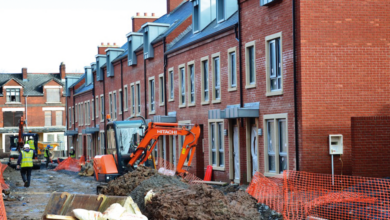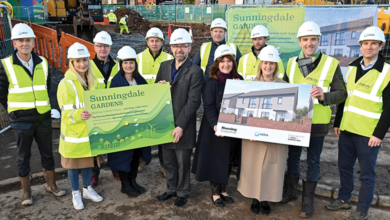The state of social housing
 Social housing is under severe pressure but the sector has the skills to identify innovation solutions, Paddy Gray tells the Northern Ireland Housing Conference.
Social housing is under severe pressure but the sector has the skills to identify innovation solutions, Paddy Gray tells the Northern Ireland Housing Conference.
Housing professionals need to think outside the box on increasing supply and prove the benefits of housing in other policy areas, according to Paddy Gray.
The professor of housing at the University of Ulster explained that investing in social and affordable housing was not just about supply but about “people as well and communities and we need to remember that.”
At present, though, there was a housing shortage in the system with a shortfall of 4,000 dwellings per year. The Housing Executive, using the university’s stock model, estimates that around 2,000 social housing units are needed per year. The Programme for Government is committed to 8,000 over a five-year period, which may result in “a deficit in what we require.”
New housing construction had “plummeted” from 14,000 in 2006-2007 to 4,500 in 2011-2012, with a clear impact on the construction industry. Waiting lists are at an all-time high with 40,000 people waiting for housing and 20,000 people declared homeless in 2011-2012.
While 90 per cent of public housing remains segregated, the 2010 Northern Ireland Life and Times Survey found that 83 per cent of the general public would prefer to live in a mixed neighbourhood. This was equally supported by Catholics and Protestants.
Finance for mortgages had “practically dried up” in the financial crisis. Gray characterises this as “generation rent” where young people have to rent accommodation “because they can’t afford the high deposits they’re being asked [for], in the stringent controls in the financial sector.”
Great Britain is moving towards local housing allocation policies. A fundamental review of allocations in Northern Ireland is on-going, with work led by the University of Ulster and University of Cambridge. He expected the review of the housing system to result in more money being invested in housing and communities.
“Traditionally, social housing covered a range of income groups but it has become an increasingly scarce commodity,” Gray remarked. Between 2001-2002 and 2010-2011, its share of occupied stock had fallen from 21 per cent of housing stock to 16.6 per cent.
The sector was becoming “increasingly residualised” with many tenants living in isolated, stigmatised and polarised neighbourhoods, with those problems made more acute by ethno-religious segregation.
Eighty per cent of households in the sector had an annual gross income of less than £15,000. Thirty per cent were living on less than £10,000, compared to 23 per cent of those in private rented housing and 12 per cent of owner-occupiers.
Gray contends that the objectives of social housing in the 21st century need to be made clearer. The Hills review of social housing in England, published in 2007, highlighted an “inherent contradiction” between the principal benefits of social housing (affordable rent and security of tenure which should support employment) and the higher rate of worklessness among tenants.
A right to adequate housing is set out in the UN’s International Covenant on Economic, Social and Cultural Rights, which was ratified by the UK in 1976. The committee overseeing the covenant has interpreted this as “a right to live somewhere in security, peace and dignity” which also includes legal security, access to services, and affordability and accessibility, particularly for disadvantaged groups.
Gray is encouraging the social and private housing sectors to ask whether this is provided in practice across Northern Ireland. The housing of vulnerable and disadvantaged people, he said, should be prioritised without concentrating poverty and increasing social fragmentation. How to allocate an increasingly scarce commodity with reduced investment was another key question.
At present, the tenure system is “very one-sided” with the majority of construction taking place in the private sector. Properties could easily move in from social housing to owner occupation but not from owner occupation to social housing.
“This inflexibility makes it hard for tenure balances to adjust to changes in need,” Gray added. “We need to consider the needs of the person seeking accommodation as well as the needs of the builders and the landlords.”
The housing sector needed to address the reasons for high levels of poverty and deprivation in social housing and consider whether security of tenure should still be offered for life. The Hills review had also suggested that housing officers could offer skills advice. Housing professionals needed to understand the connections between housing, employment, health, education and welfare, and explain how good housing can reduce expenditure in the related policy areas.
“The one thing that is certain is that there will be continued reductions in public resources available for social housing,” he stated. Looking at the future of Northern Ireland’s housing policy, Gray concluded: “Social housing must have a central role to play and it has to become a progressive force rather than a pejorative term.”
Innovation in supply
New builds and increased tenure flexibility for existing stock can both increase supply. The UK Department for Communities and Local Government estimates that every
£1 million of new housing output supports 12 additional jobs per year: seven employed directly and five indirectly. For every £1 invested in housing, an estimated £2.60 is generated elsewhere in the supply chain.
The Housing Executive and housing associations were increasingly looking to other tenures for supply and needed to attract private investment while interest rates were low, buy up land while prices were relatively low, and bring back the 55,000 empty properties into use.
Only 0.6 per cent of UK housing was in co-operative housing, compared to 10 per cent in Germany. On regulating landlords, he asked: “What’s so different about renting a house and driving a car? With a car, nobody questions having a licence. It can be taken away if you break the law.”





